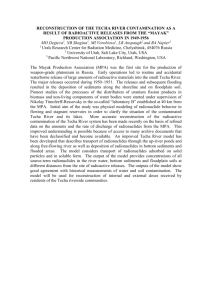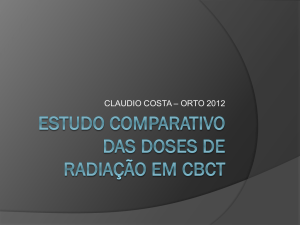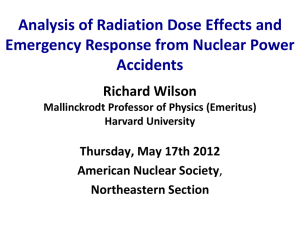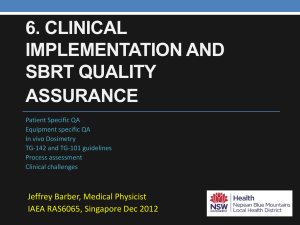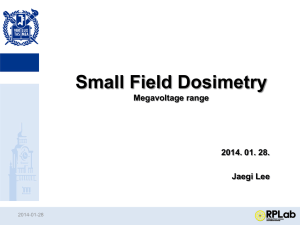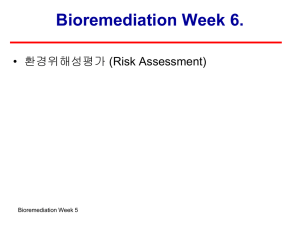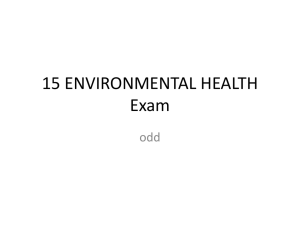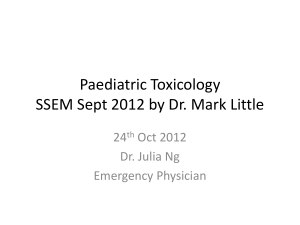Anspaugh-Radiation_Dose_Reconstruction
advertisement
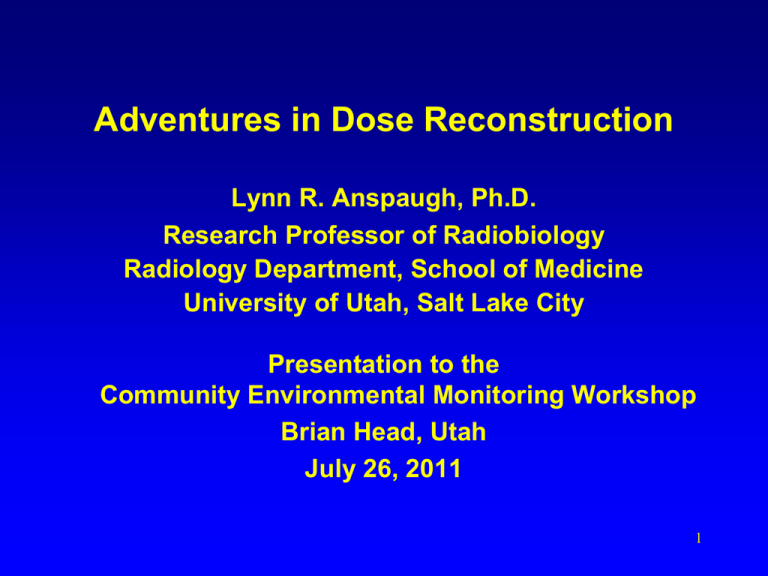
Adventures in Dose Reconstruction Lynn R. Anspaugh, Ph.D. Research Professor of Radiobiology Radiology Department, School of Medicine University of Utah, Salt Lake City Presentation to the Community Environmental Monitoring Workshop Brian Head, Utah July 26, 2011 1 Outline of Presentation • What is dose reconstruction? • NTS Downwinders – ORERP – HHS Feasibility Study • Chernobyl • Semipalatinsk • Mayak Production Association – Techa River Cohort – Ozersk Children’s Cohort 2 What is radiation-dose reconstruction? • It involves reconstruction of radiation doses for members of the public exposed to effluents from a facility or exposed to a “practice.” • Typically large numbers of the general public are of interest—1000s to 100,000s or even 100,000,000s. • Exposure may have been acute or chronic. • It is common for environmental dose reconstruction to be performed long after the beginning of exposure. 3 Hierarchy of methods of dose reconstruction • Individual biologic analysis • Dosimetry of materials in homes—like thermal or optical luminescence of quartz extracted from bricks or porcelain • Analysis of environmental residues • Reconstruction of releases, plus atmospheric transport models 4 My first major project was calculating dose to downwinders of the Nevada Tests. Bruce Church was Project Manager. 5 Analysis of environmental residues • Historical measurements of external gamma-exposure rate • Deposition densities, historical or current data – Short-lived radionuclides (historical only) – 90Sr – 129I – 137Cs – 239+240Pu, plus the ratio of 240Pu-to-239Pu 6 Environmental behavior of radionuclides 7 • 100 atmospheric tests plus many vents. • Collective external dose in the domain was 12,000 person-Gy. • The U.S. Congress implemented a compensation program, but based on politics, not science. 8 Collective dose, organ-gray 6 10 5 10 4 10 3 10 2 10 1 Thyroid LLI ULI Bone surface Red bone marrow Small intestine Stomach wall Total body Liver Kidney Ovaries Uterus Bladder wall Adrenals Spleen Muscle Pancreas Testes Lungs Breast Brain Skin 10 Organ 9 There were two follow-on studies mandated by the U.S. Congress. • Dose to the thyroid from 131I for the 48 contiguous states • Dose to other organs from a select list of major doseforming radionuclides. – External – Internal 10 11 12 The ORERP work led to involvement at Chernobyl 13 The destroyed reactor 14 Acute health effects • Two workers died from physical trauma. • 134 plant and emergency personnel had acute radiation syndrome (ARS). • 28 died • 13 of the 28 had bone-marrow transplants, but 12 died. • 3 of the 13 might have survived without the transplants. • No member of the public had ARS. 15 The first UNSCEAR dose assessment for Chernobyl was published in 1988. 16 The 2000 UNSCEAR report was controversial. It reported there was no substantial evidence of latent health effects other than childhoodthyroid cancer. This finding was rejected by the governments of Belarus, Ukraine, and the Russian Federation. There was lack of agreement among the UN agencies. 17 Chernobyl • Doses were initially calculated based upon reported values of 137Cs deposition, or other environmental values. • Thyroid measurements had been taken and were made available. • Later on, a huge data base on environmental measurements and biologic dosimetry (including whole body counts) became available. 18 Ground depositions of 137Cs 19 Ground depositions of 137Cs 20 21 22 23 24 Thyroid cancer in young people after Chernobyl • Major increase in risk : – 6000 cases among those who were below 18 at the time of the accident (1992-2005) • Many epidemiological studies – Confirm increased risk – Provide estimates of risk per Gy – Most cases attributable to radiation from the accident Adapted from E. Cardis, Intl. Agency for Research on Cancer, Lyon 25 Estimates of collective thyroid dose in the three more affected countries Country Russian Federation Belarus Ukraine Total Collective thyroid dose, man-Gy 300,000 550,000 740,000 1,600,000 26 A good source of detailed information about Chernobyl. You can download it from the Internet. 27 Similar studies have been undertaken at the former Soviet test site, Semipalatinsk, located in Kazakhstan. • Joint Russian-U.S. methodology • New problem—the secretion of radioiodine in – Camels – Horses – Sheep • Basis of general dose reconstruction is historic measurements of gamma-exposure rate, plus current TLD and EPR measurements. 28 29 The Soviet ‘Sedan’ in Kazakhstan 30 The Mayak Production Association • Was the first facility for the production of Pu in the former USSR. • Began operations in 1948. • Due to unrecognized technological failures, released about 1017 Bq of fission products into the Techa River. • Most of the release occurred during 19491951, but lower level releases continued through 1956. • There were also substantial airborne releases of 131I. 31 1 1954 a el y sh i M Bas Metlinsky Pond Metlino (7 km) r ive R k 1956 Rive r 1952 kaz yk 1950 Irtyash Lake Kyzyl-Tash Lake r 10 ve Ri 100 et Is Radionuclide composition, % 90Sr - 11.6 89Sr 8.8 137Cs - 12.2 95Zr, 95Nb 13.6 103,106Ru - 25.9 Rare-earth elements - 26.8 ka ish ut r Sh ive R Average daily release, TBq Techa River 1949-1956 Muslyumovo (78 km) Techa River Brodokalmak (109 km) Zyuzelka River 32 The exposed population • Were members of an unselected general population. • Lived along the banks of the Techa River in 40 villages. • Were exposed mainly via – Drinking water drawn from the River, – Consumption of foods contaminated by river water, – External exposure from the contaminated sediments and flood-plain soils. • Were relocated from the more heavily contaminated villages beginning in 1955. 33 Pictures of the Techa River settlements Former Metlino located at 5-7 km from the site of release Muslyumovo located at 78 km from the site of release As in 1965 As in 2000 34 The Techa River dosimetry and epidemiology projects are integrated. Disease classification Risk derivation Personal Information Disease Follow-up Dose Dosimetry system Dose calculation All information is kept in a central database at the URCRM. 35 Reconstruction of internal dose--89,90Sr • 90Sr is one of the main contributors to dose, due to its hydrologic behavior • It is retained the body in bone and teeth and has been studied over long periods in the same individuals. • A special whole body counter is used and is capable of measuring body burdens of 90Sr through the detection of bremsstrahlung from the decay of 90Sr/90Y. 36 37 Our dosimetry family portrait 38 ETRC solid cancer and leukemia dose responses derived from TRDS-2000 Non-CLL Leukemias 10 0.6 Excess Relative Risk Excess Relative Risk Solid Cancers 0.4 Linear-Quadratic 0.2 Linear 0 0 0.2 Stomach Dose, Gy 0.4 8 6 Linear 4 Linear-Quadratic 2 0 0 0.5 1.0 RBM Dose, Gy Krestinina LYu, Preston DL, Ostroumova EV et al. Protracted radiation exposure and cancer mortality in the Techa River Cohort. Radiat Res 164:602-611; 2005. 39 Another cohort of interest is young children living in Ozersk during the period of major releases of 131I • Epidemiologic studies have indicated an increased prevalence of thyroid nodules and an increased incidence of thyroid cancer in the exposed population. • Study of this cohort could be very useful in resolving differences in experiences from exposure to 131I from Chernobyl vs. U.S. experience from the Nevada Test Site and the Hanford Works. 40 Preliminary estimates of 131I release from the Mayak Plant 41 42 Thank you for your attention. 43
